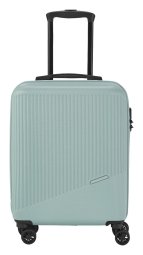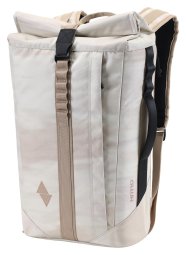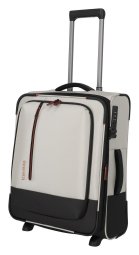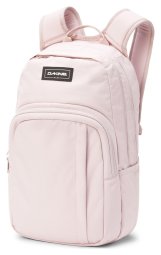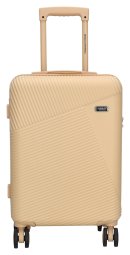Whether it's your faithful companion in the city, at school, or on your travels, a backpack or travel suitcase takes a serious beating every day. Dust, mud, food scraps, sweat, and even cosmetics leave traces that weaken fabrics and mar the appearance over time. Regular and proper cleaning of your backpack and suitcase is therefore essential. Not only will you maintain their appearance, but more importantly, you will extend the life of the entire piece of luggage. In this complete guide, you'll learn how to effectively and safely clean a backpack made of various materials, and how to care for modern hardshell suitcases.
Contents:
- Before Cleaning: Principles to Avoid Damage
- Cleaning Backpacks: By Hand or in the Washing Machine?
- Special Procedures for Stubborn Stains and Odors
- Suitcases: Proper Care for Hardshell and Textile Models
- Drying and Protection: The Key to Extending Lifespan
- How to Properly Clean a Backpack or Suitcase - Frequently Asked Questions
- Care That Pays Off: Extending the Life of Your Luggage
Before Cleaning: Principles to Avoid Damage
Before you start the actual washing, it's crucial to prepare the luggage to minimize the risk of damage. This step often determines the success of the entire process.
Checking the Manufacturer's Label
No matter how quickly you want to get started, always read the manufacturer's instructions on the label first. Different backpacks and suitcases are made from different materials and therefore require specific care. Some backpacks made of very durable synthetic materials can be machine washed, while other models with membranes, leather elements, or complex constructions must be cleaned by hand only. Ignoring the label is the most common cause of damage. If the manufacturer's label is illegible or missing, always opt for the gentler hand-washing method.
Emptying and Removing Coarse Dirt
The first mechanical step is to completely empty it. Empty the backpack or suitcase of all items and check all internal and external pockets. Then, focus on removing dirt:
- Shake out the suitcase or backpack to get rid of coarse and loose dirt, dust, sand, and crumbs. If these small particles remain in the fabric, they can act like sandpaper during the subsequent wash.
- Use a vacuum cleaner with a narrow nozzle to suck up dust from corners, seams, and folds.
- Check the zippers and the functionality of all buckles. Open zippers will make it easier to get inside and prevent damage to the zipper during machine washing (if permitted). Pay special attention to dirt on the zippers.
Cleaning Backpacks: By Hand or in the Washing Machine?
For backpacks, it is generally recommended to choose the gentlest method possible. While it's tempting to throw a backpack in the washing machine, hand washing will extend its life and is often the best choice, especially for more expensive models or school backpacks with a rigid back.
Hand Cleaning a Backpack: The Gentler and Safer Choice
The manual method is ideal for school backpacks, hiking backpacks with a metal frame, or sports backpacks that have a waterproof coating or treatment that could be completely destroyed by machine washing. The process of cleaning your backpack should be systematic.
Step-by-step hand cleaning process:
- Prepare the solution: Fill a bathtub or large container with lukewarm water. Add a small amount of mild detergent (ideally liquid, without bleach and fabric softener) or mild soapy water. Avoid harsh chemicals that can damage fabrics and cause color fading.
- Washing: Use a soft brush or a clean cloth. Scrub the entire surface, focusing on stained areas (back, straps, bottom). Clean thoroughly but gently – excessive scrubbing can cause fiber damage.
- Rinsing: Rinse the backpack thoroughly under clean, lukewarm running water until all detergent residue is removed. Soap residue can damage the fibers and create marks.
Washing a Backpack in the Machine: When is it Safe?
You should only consider washing a backpack in the machine if it is explicitly permitted on the label. Even then, strict rules must be followed to prevent damage. As a general rule, you should only wash simple, fabric backpacks without special treatments or reinforcements.
|
When I can wash a backpack in the machine |
When NOT to use the washing machine |
|---|---|
|
The backpack is made of a durable synthetic material (nylon, polyester). |
It has leather elements, sequins, reflective elements, or is decorated. |
|
The label has a symbol for machine washing. |
It has a metal frame or rigid plastic reinforcements. |
|
It is heavily soiled and hand cleaning is not enough. |
It has special waterproof membranes or is coated with a layer of waterproofing. |
|
You use a special laundry bag or a pillowcase. |
It is equipped with electronic or battery-powered accessories. |
If you decide to machine wash, always set the program to hand wash or delicate (maximum 30°C and DO NOT use the spin cycle, or only at very low speeds). Use a minimal amount of liquid detergent.
Special Procedures for Stubborn Stains and Odors
Ordinary dirt can be handled with water and soap, but for more stubborn stains and unpleasant odors, stronger yet still safe methods are needed.
Quick Help for Stubborn Stains
Removing dirt quickly is essential. The longer stains remain on the fabric, the harder they are to get rid of.
- Grease stains: Immediately sprinkle the grease stain with baking soda or cornstarch, which will absorb the grease. Let it sit for a few hours and then brush it off with a soft brush. Then apply a little liquid dish soap and clean with lukewarm water.
- Mud: Let the mud dry completely. Never try to scrub wet mud – you'll just rub it in deeper. Simply scrape or wipe off the dry mud with a dry cloth. Clean the rest with soapy water and a cloth.
- Ink and paint: Alcohol-based cleaners or isopropyl alcohol are suitable for these stains, but always test them on a hidden part of the luggage first to avoid color fading.
Cleaning the Interior and Lining
Don't forget that the inside of the luggage also absorbs odors and dirt. Clean the interior with a damp cloth, ideally with a solution of water and vinegar (vinegar is a natural deodorant). The cloth should only be damp, not wet, to avoid unnecessarily soaking the luggage. To combat a musty smell, baking soda is again excellent. Sprinkle it inside the backpack or suitcase, let it sit overnight, and vacuum it up in the morning. You can also let the backpack air out in the fresh air.
Special Care for Leather Elements and Leather Backpacks
If your backpack contains leather elements, or is even made entirely of real leather, completely different rules apply. Never wash leather in a washing machine, or even try to soak it. Water, and especially washing chemicals, would dry out the leather, cause it to harden, and could permanently damage it.
- Cleaning: To clean your backpack with leather parts, use only special cleaning foams and conditioners designed for leather, or just a soft cloth very slightly dampened in lukewarm water. Do not use soapy water, which dries out the leather.
- Hydration: After cleaning, it is crucial to nourish the leather with a quality balm or leather cream. This aftercare will prevent drying and cracking, thereby significantly extending its lifespan. You will also prevent dirt from soaking in deeply.
- Stains: Do not use alcohol or aggressive cleaners on more stubborn stains. First try a dry cloth, then a special leather eraser.
Suitcases: Proper Care for Hardshell and Textile Models
Cleaning suitcases is usually easier than backpacks. We distinguish between two basic types of suitcases, each requiring a slightly different approach. The goal is to preserve not only the appearance but also the functionality.
Caring for Hardshell Suitcases
Hardshell suitcases made of polycarbonate, polypropylene, ABS, or aluminum are durable and easy to maintain. Most external dirt can simply be wiped off with a damp cloth and a little mild soap.
Important points when cleaning hardshell suitcases:
- Surface: Do not use harsh brushes, abrasive sponges, or aggressive chemicals to clean hardshell suitcases. You could scratch the glossy surface or damage the matte texture. Always use a cloth or a soft sponge.
- Wheels: Suitcase wheels are often full of dust, sand, or hair. Turn the suitcase upside down and use a damp cloth and a toothpick to remove all debris. This is crucial for maintaining their functionality and smooth running.
- Handles and telescopic handles: These parts just need to be wiped with a disinfectant wipe and ensure that no dirt gets into the telescopic mechanism, which could damage its extension.
Cleaning a Textile Travel Suitcase
Textile suitcases are cleaned similarly to backpacks, but they are often larger and cannot be easily submerged in water. Therefore, it is ideal to perform local cleaning.
- Removing dirt: Clean the surface dirt with a vacuum cleaner and a soft brush.
- Hand washing: Use a gentler procedure with soapy water and a cloth. Scrub only the stained areas, avoid soaking the backing. Don't forget to rinse thoroughly with clean lukewarm water and blot the moisture with a dry towel.
Drying and Protection: The Key to Extending Lifespan
Improper drying is one of the biggest risks that can cause mold, a musty smell, or shorten the life of luggage.
Proper Drying Without Damage
After finishing cleaning the backpack or suitcase, it is necessary for it to dry really thoroughly.
Principles of proper drying:
- Open all zippers and pockets wide.
- Place the backpack or suitcase in a well-ventilated area, ideally in the shade (e.g., on a terrace, in the garage, in a bathroom with an open window).
- Do not use a dryer, do not dry on a heater or in direct sunlight. High temperatures can damage materials, plastic parts, and cause color fading.
- Drying time can be up to 24-48 hours. Make sure even the most hidden seam is dry before storing the luggage.
Final Protection (Waterproofing)
Once your luggage is perfectly dry, you can further increase its durability.
- Waterproofing: Applying a waterproofing spray (suitable for fabrics) will help create a protective layer that will make it significantly harder for it to get dirty again and will reduce the risk of dirt soaking into the fibers. This will extend the life of your backpack.
Tip: Preventing dirt is better than removing it. It's a good idea to wipe the backpack with a damp cloth after every trip, especially if it was exposed to mud or dust. This will prevent dirt from becoming deeply embedded.
How to Properly Clean a Backpack or Suitcase - Frequently Asked Questions
- How do I clean stains from a backpack?
To remove stains from a backpack, we recommend using a mild detergent and water. Apply the mixture to the stain and gently rub it with a cloth or soft brush. After cleaning, rinse thoroughly and let the backpack air dry. - How do I properly wash a backpack in the washing machine?
If you want to wash a backpack in the washing machine, first check the manufacturer's instructions. Most backpacks should be washed on a gentle cycle at a low temperature. Use a bleach-free detergent and remember to put the backpack in a protective bag. - How do I clean a travel suitcase?
You can clean a travel suitcase with a soft cloth dipped in water with a mild cleaning agent. Avoid using aggressive chemicals that could damage the surface of the suitcase. After cleaning, let the suitcase dry thoroughly. - How do I properly waterproof a backpack?
Use a waterproofing spray designed for textiles, apply it evenly to a dry and clean backpack, and let it dry according to the manufacturer's instructions. - How do I dry a backpack after cleaning?
You should air dry your backpack and never put it in a dryer. It is ideal to place it in a dry place away from direct sunlight and heat to prevent material deformation. - How do I care for a hardshell suitcase?
A hardshell suitcase should be cleaned regularly with a damp cloth and a mild cleaning agent. Avoid strong chemicals that could damage its surface. Keep the suitcase in a dry place to prevent mold growth. - Why shouldn't I use a washing machine to clean a backpack?
Using a washing machine can damage the structure and material of the backpack, especially if it has special reinforcements or is made of more delicate materials. Always follow the manufacturer's instructions.
Care That Pays Off: Extending the Life of Your Luggage
See? Proper care for your backpack and suitcase is not rocket science, it just requires patience and knowledge of materials. The key is prevention, timely removal of dirt, and following the instructions on the manufacturer's label. With this approach, you will not only keep your luggage in perfect condition, but you will also reliably extend the lifespan of all its components – from the zippers to the fabric itself.
Regular cleaning of backpacks and suitcases is an investment that will pay off many times over. However, if your old luggage is past its prime, or you simply need a new, durable, and easy-to-maintain model, check out our current offer of backpacks and suitcases on Bagalio.eu.


